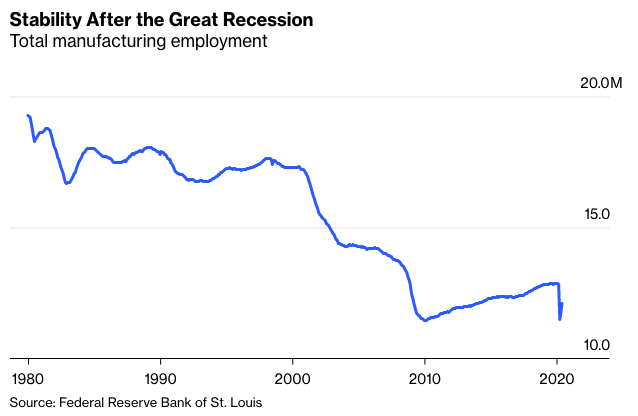Working-age men have had it rough in postwar recessions when the economy typically sheds manufacturing and construction jobs. Then, in recoveries, men have been slow to find work as health care and other service-sector industries grow faster and manufacturing jobs shift overseas. That's not what happened in this downturn, nor in the nascent recovery. For the first time in decades, men may be the relative winners in this economic cycle.
The best way to visualize this might be a historical chart of manufacturing employment. More than 70% of manufacturing workers are men. Beginning in the two early ‘80s recessions, manufacturing employment began to stagnate and struggled to recover in the ensuing expansions. The 2001 and 2007-09 recessions were worse, in both cases resulting in the loss of several million manufacturing jobs. Although the U.S. had a modest recovery in manufacturing employment in the 2010s, the gains weren’t enough to get back to the employment levels of 2006.

For a variety of reasons, the industries men are more likely to work in have been more resilient so far to the economic disruption brought about by the coronavirus. Construction, an industry that's almost 90% male, has bounced back quickly as low interest rates and a tight inventory of properties for sale have helped support the demand for new homes. PulteGroup, one of the U.S.’s largest homebuilders, noted in its earnings conference call last week that it had rehired the majority of its furloughed workers and may need to add employees to meet demand.
Pockets of manufacturing have shown robust demand as well, particularly related to the housing market. Home-appliance maker Whirlpool cited growing demand throughout its product lines on its earnings call last week, and the company’s stock is at a two-year high.
Another industry dominated by men, transportation and warehousing, which encompasses jobs like truck drivers and e-commerce fulfillment center workers, has seen a quick recovery in job postings on employment site Indeed. Even with overall job postings down 22% from a year earlier, driving jobs are up 4.7% and loading and stocking jobs are down just 4.3%.
Jobs in these industries—manufacturing, construction, transportation and warehousing—have fallen as a share of total employment for decades, particularly during recessions, but they've popped since the onset of the pandemic.

Industries with a more balanced gender mix or those with more women, such as retail, travel and dining, have had bigger job losses.
The economic conditions coming into the pandemic and the ensuing behavioral changes brought about by the disease, shows why this is so. The homebuilding industry, and the associated construction jobs, has been poised for a rebound amid low inventories, shifting demographics as the large millennial generation ages into its home-buying years and falling mortgage rates that increase affordability.








